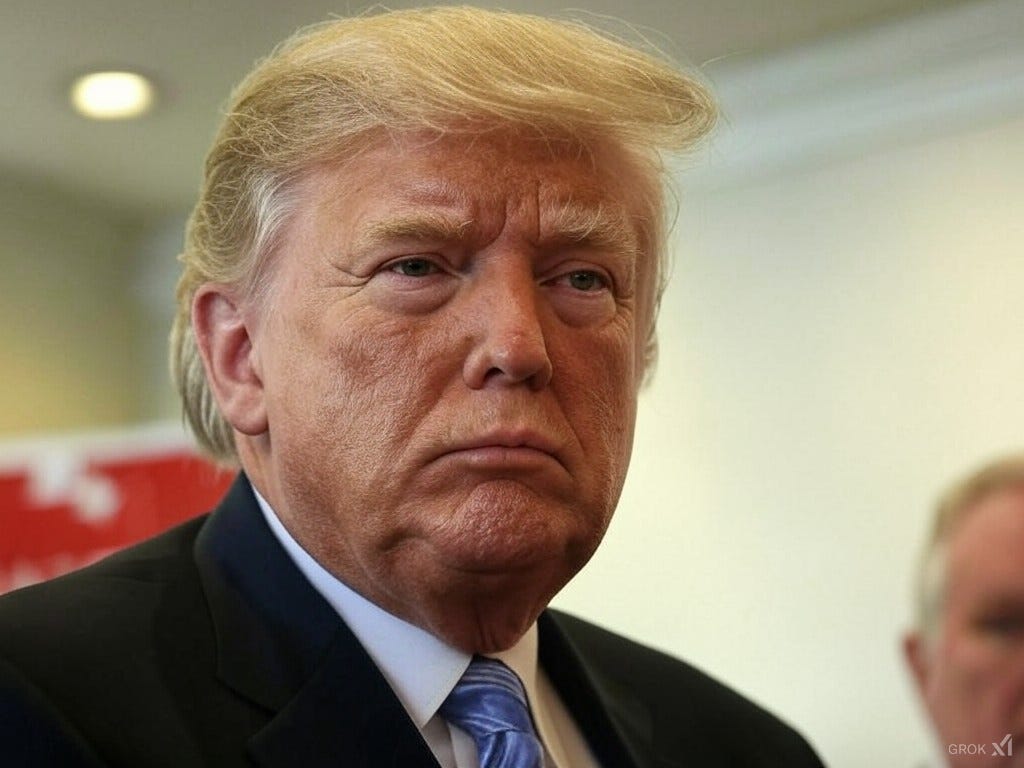Trump's "All Hell Will Break Out" Threat Likely Forced Israel-Hamas Ceasefire Deal
Just days before Trump's inauguration (Jan 20th) Hamas agrees to a deal with Israel...
It’s possible that the deal would’ve happened without Trump taking office soon… but I’m skeptical.
My guess? Hamas fears Trump’s leadership (even if publicly stating they don’t) and Israel just wants hostages returned.
Trump’s Role in the Israel-Hamas Ceasefire…
Biden has been trying to get a deal done between Israel and Hamas for a while. Laying the groundwork essentially gave Hamas an “out” before Trump took office… and I think they waited, waited, and realized they better quick accept a deal or risk complete no-holds-barred obliteration under Trump.
The Road to a Israel-Hamas Ceasefire…
For 15 months, Israel and Hamas were locked in a brutal war that left thousands dead, decimated much of Gaza’s infrastructure, and displaced 90% of its 2.3 million people.
Multiple attempts at short truces collapsed. Israeli Prime Minister Benjamin Netanyahu insisted on dismantling Hamas’s military capabilities, while Hamas demanded the release of Palestinian prisoners and an end to what it termed a “siege” on Gaza.
Biden’s Early Diplomatic Framework
May 31, 2024: President Biden publicly outlined a plan for a potential ceasefire, earning unanimous support from the U.N. Security Council.
Months of Negotiations: Biden’s envoy, Brett McGurk, worked with Qatar, Egypt, and other regional mediators to hammer out the logistics of a possible deal—hostage exchanges, timelines for Israeli troop withdrawal, and mechanisms for allowing humanitarian aid.
Stalled Progress: Despite consistent U.S. engagement, Israel and Hamas remained far apart on key issues, especially the immediate release of hostages in Gaza and the scale of prisoner releases in Israel.
Enter Trump 2025: The Inauguration Deadline
Trump’s Looming Presidency
Election Victory: Donald Trump won the November 2024 U.S. presidential election and was slated to take office on January 20, 2025. His campaign statements on the Middle East were uncompromising: He vowed to give Israel the fullest possible support and warned Hamas of “severe consequences” if the hostage crisis persisted.
Credible Threat of a Harder Line: Trump’s history of abrupt, aggressive foreign policy moves added weight to his ultimatums. Both Israeli and Hamas leadership knew that once Trump took office, diplomatic niceties could be replaced by unreserved backing for Israeli military escalations.
The Specific Threats to Hamas
“All Hell Will Break Out”
Trump repeatedly stated that if Hamas did not free hostages by his January 20 inauguration, “all hell will break out in the Middle East.” (LINK)
Though vague, these words hinted at allowing Israel a free hand to intensify military strikes—potentially with advanced U.S. weaponry no longer constrained by humanitarian considerations.
“Hell to Pay”
In early January, Trump doubled down: “There will be hell to pay … It will not be good for Hamas. And it will not be good, frankly, for anyone.”
Analysts interpreted this as a willingness to impose blanket sanctions on Hamas and the entities or nations supporting it, as well as a refusal to restrain Israel’s military ambitions in Gaza.
How These Threats Likely Accelerated Talks
Fear in Hamas: Even if Hamas was uncertain whether Trump would directly deploy U.S. forces, the risk of dramatically harsher military action by Israel—fully greenlit by the White House—was enough to push Hamas negotiators to act.
Pressure on Netanyahu: Netanyahu had long taken a firm stance, but faced domestic and international scrutiny over soaring casualties in Gaza. Trump’s threats paradoxically gave Netanyahu extra leverage: either Hamas agreed now (under Biden’s more moderate approach) or faced Trump’s escalations later.
Urgency for a Deal: The five-day window before inauguration essentially became a ticking clock. From January 15 onward, negotiators scrambled to finalize even the smallest details.
The Final Agreement: What Was Actually Signed?
Official Confirmation
Qatar’s Prime Minister announced on January 15 that a “comprehensive ceasefire deal” had been reached, with Israel and Hamas both consenting to pause major hostilities starting Sunday, January 19.
U.S. & Qatar as Guarantors: Mediators from the U.S. and Qatar confirmed that the agreement included mechanisms to verify each phase of the ceasefire, including the transfer of hostages and prisoners.
Key Terms and Phases
Six-Week Ceasefire
A formal halt to offensive operations for an initial six-week period, subject to extension if negotiations on a permanent arrangement progress.
Hostage Releases (Phase One)
33 Individuals Freed: Women, children, older adults, and wounded civilians held by Hamas.
Timing: The first wave of hostages to be released as early as the first week of the ceasefire. Israel and the U.S. insisted on a clear timetable for each group’s handover.
Israeli Prisoner Releases
Hundreds of Palestinian Detainees: Mostly women and minors with lesser charges, though final numbers varied among sources.
Verification: International and regional observers, including Qatar and Egypt, were assigned to confirm these releases in tandem with Hamas freeing hostages.
Israeli Troop Withdrawal
A gradual, phased withdrawal of the Israeli ground forces from key zones in Gaza, reducing direct confrontation and enabling initial humanitarian relief.
Humanitarian Provisions
Increased Aid: Greater volume of medical supplies, food, and reconstruction materials to be allowed through Gaza’s border crossings.
Monitoring Mechanism: If Hamas or other factions fire rockets or violate the ceasefire, Israel could reinstate the blockade.
Biden and Trump’s Shared Credit
Biden’s Diplomatic Framework: The White House underscored that Biden’s plan from May 2024 laid the essential groundwork and shaped the final structure of the ceasefire.
Trump’s “Final Push”: Trump’s camp, including envoy Steve Witkoff, emphasized that only the fear of a severe U.S. response after January 20 forced Hamas to accept terms they had previously resisted.
In the Negotiating Room: Last-Minute Snags
A.) Doha Talks in Overdrive
McGurk and Witkoff: Biden’s Mideast adviser Brett McGurk and Trump’s envoy Steve Witkoff spent grueling hours in Doha, each pressing their respective vantage points but presenting a united U.S. front.
Hamas’s 11th-Hour Demands: On January 15, Hamas reportedly requested alterations to border security provisions and the schedule of prisoner exchanges. Negotiators from the U.S., Qatar, and Egypt “held very firm,” as one senior U.S. official put it, until Hamas dropped its last-minute conditions.
B.) Trump’s Personal Messages
Social Media Posts: Trump fired off posts on Truth Social, warning that if Hamas delayed, the consequences post–January 20 would be “unthinkable.”
Effect on Netanyahu: Israeli sources indicated Netanyahu’s office welcomed this stance, as it reinforced Israel’s position in rejecting Hamas’s late-stage demands.
Could Trump Have Really Unleashed “All Hell”?
1. Military Levers
Arms Restrictions Lifted: Trump could have authorized advanced arms sales or expedited shipments to Israel that Biden had regulated, such as bunker-buster bombs or additional missile defense systems.
Greenlight for More Intensive Strikes: Israel would have felt emboldened to intensify airstrikes against what remained of Hamas leadership in Gaza.
2. Economic and Diplomatic Squeeze
Harsh Sanctions: Potential blacklisting of key Hamas figures, freezing assets in Gulf states, and penalizing countries that host Hamas operatives.
Stopping All Humanitarian Aid: Trump demonstrated in his previous term a willingness to cut funding to Palestinian initiatives. He might have leaned on U.S. partners to scale back relief unless Hamas complied.
3. Real Constraints
Hostage Safety: Excessive force could have endangered U.S. and Israeli captives, triggering domestic backlash in the U.S.
Regional Partnerships: Qatar and Turkey host critical U.S. military installations, complicating any severe diplomatic rifts.
No New Wars Pledge: Trump campaigned on avoiding new entanglements, suggesting direct U.S. intervention was unlikely—though it remained an unsettling unknown for Hamas.
Israel-Hamas Deal: Implications and Reactions
Israeli Public
Calls for Approval: Israeli President Isaac Herzog publicly urged Netanyahu’s Cabinet to endorse the ceasefire. Demonstrators outside Tel Aviv’s military headquarters carried posters of hostages, demanding quick adoption of the deal.
Palestinian Response
Celebrations in Gaza: Crowds took to the streets in Khan Younis and elsewhere, expressing cautious relief over the anticipated pause in bombing and the possible return of displaced families to their neighborhoods—though many homes lie in ruins.
U.S. Political Landscape
Biden’s Announcement: Biden hailed “dogged and painstaking American diplomacy” in securing the deal, noting that “for the past few days, we have been speaking as one team” with Trump’s incoming administration.
Trump’s Social Media Victory Lap: Trump declared the ceasefire “could only happen” with his election triumph, asserting it signaled a forthcoming era of “peace through strength.”
Did Trump’s Threats Matter More Than Biden’s Diplomacy?
Obviously... Hamas doesn’t want Trump to greenlight Israel to glassing Palestine and/or all humanitarian aid cut off to the region.
Trump’s upcoming inauguration introduced a fear factor that drastically shortened Hamas’s timeline for negotiations.
Faced with the possibility of unrestrained Israeli offensives and harsh U.S. sanctions, Hamas conceded on hostage releases and other sticking points that had previously stalled the talks.
The Timing
Deal Deadline: With the clock ticking down to January 20, both Hamas and Israel saw a strong incentive to sign an agreement under Biden’s comparatively moderate approach rather than risk a confrontation with Trump’s incoming administration.
Israeli Confidence: Netanyahu’s government knew it would have a “friendlier,” more hawkish White House if Hamas continued to defy the U.S. Some analysts say this allowed Israel to hold a firm line: “Sign now or face worse consequences later.”
Expert Assessments
Many credit Trump’s intimidation tactics with giving negotiations the final push.
However, the diplomatic groundwork laid by the Biden team—plus the involvement of Qatar and Egypt—was crucial in shaping the actual terms (hostage releases, prisoner swaps, humanitarian aid).
In other words, the fear of a harder-line U.S. approach under Trump created an environment in which Hamas couldn’t risk waiting.
As a result, the ceasefire agreement came together in the nick of time, just days before the transition of power.
Whether or not it holds in the long run will depend on the Trump administration’s follow-through, ongoing diplomatic efforts, and the commitment of both Israel and Hamas to a sustained, negotiated peace.
Takeaway: Trump Pushed Hamas’ Hand
Donald Trump’s vague-yet-forceful warnings (“all hell will break out,” “there will be hell to pay”) injected a surge of unpredictability and urgency into the final days of the Israel-Hamas negotiations.
While these statements lacked detailed specifics (e.g., no direct mention of a U.S. bombing campaign or a ground invasion), their ambiguity was part of the pressure tactic—Hamas and regional players believed Trump might unleash more severe measures or give Israel carte blanche to escalate.
Ultimately, security experts argue:
Trump’s intimidation accelerated Hamas’s decision to release hostages and agree to a ceasefire.
Biden’s groundwork provided the structural framework that made a negotiated deal possible.
Regional mediators (Qatar, Egypt) and Israel’s push for a swift resolution ensured the final agreement took shape just days before Trump’s inauguration.
How much did Trump contribute? I think a lot. In terms of pressure and timing—he introduced a credible threat of harsher consequences, which helped close the deal.
If Biden or Kamala stayed in charge this would’ve likely continued dragging out until something more serious happened… Biden wanted to prevent Israel from finishing the war that they didn’t start while trying to negotiate with terrorists and provide a society with an overwhelmingly terroristic ethos, humanitarian aid.
Now it’s time to see how well both sides hold up their ends of the deal.




